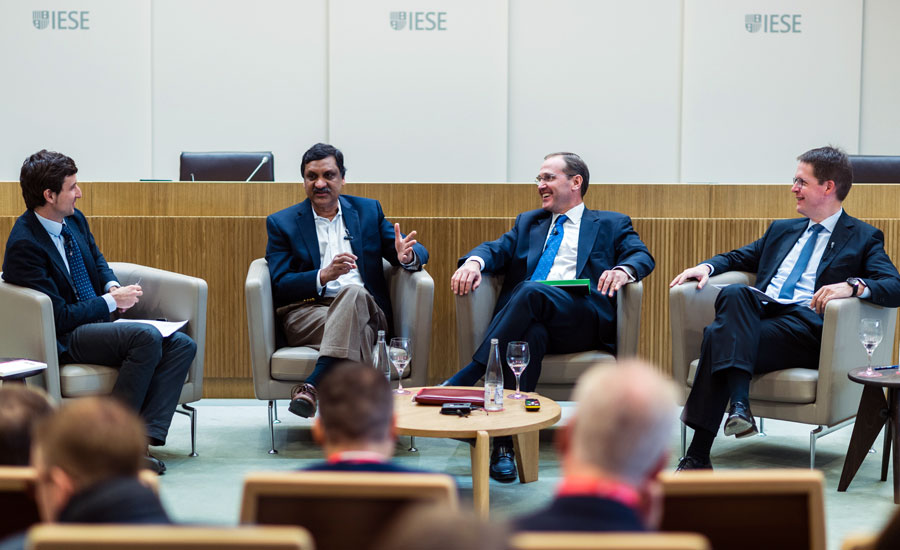Stories
How Can HR Motivate Employees to Keep Learning ?
5th Global HR Think Tank looks at people management in digital era
November 24, 2017

Want your employees to keep learning in the workplace? Listen to what they have to say and make corporate development accessible.
IESE’s 5th Global HR Think Tank addressed this and other key issues facing human resource directors during a meeting on the Madrid campus November 16.
Business leaders, experts and faculty shared thoughts and knowhow in a series of panels under the theme of “P&L: The New People and Learning Officers in the Age of Digital.” Following a thought-provoking morning, participants broke into groups to work on solutions to challenges such as artificial intelligence and the gig economy’s impact on work.
Just as marketers research consumer wants, HR leaders need to ask their employees what their training needs are, said Anant Agarwal, CEO of the massive open online course (MOOC) provider edX. Agarwal said learning providers should have an omni-channel attitude, meeting consumers’ needs seamlessly across devices wherever they are. “You need to be open to online, residential and blended learning environments,” the edX CEO said.
And online providers such as edX, Udacity and Coursera are playing a decisive role in the democratization of professional development. “MOOCs started out to make education accessible to those who can’t afford it,” noted IESE Dean Franz Heukamp.
MOOCS are also highly scalable. Bernardo Quinn, Telefónica’s global HR director, shared his experience of online learning at a time when the telecom needed particular talent. When Telefónica was short on internal capability for its migration from copper to fiber optics, it opened a MOOC on the topic to engineering students, and invited top performers to interview.
Nonetheless, the HR experts said employees rate in-person training highest in terms of satisfaction.
Get Your Teams Engaged
Corporate development is a key part of employer branding, one area where companies can demonstrate trust in their personnel. It’s been described as “everything your employees say about your company when you are not in the room,” or how a candidate perceives your brand. And in the digital era, there are plenty of “rooms” in social networking sites for top talent to check out whether the reality matches corporate communications.
So how can firms ensure those Glassdoor stories have a happy ending? “It has to be based on trust,” said Rosa Riera, Siemen’s vice president of employer branding and social innovation. “You need to lead your people not through controls, but by motivation I have to kick my team out at the end of the day,” she said. “At Siemens, we allow our colleagues from around the world to tell their individual stories,” she added.
“It’s about authenticity. It can be an aspirational story, but it has to be a true story,” added Ted Meulenkamp, Banco Santanders global head of talent acquisition and employer branding. There’s nothing fluffy about it, though. Meulenkamp pointed out that Santander receives a million job applications from university graduates each year. Only a few will be offered a job, but a positive experience at the recruitment stage is a marketing touchpoint with a million potential customers.
Walk the Walk
Time and again, the HR leaders stressed that the only way to achieve authenticity is for senior management to lead by example: its not enough for your company to advocate flexible working if your boss tuts every time you walk in at 10 am. “Oracle is a self-service organization, and it’s fairly flat. So if you were using support staff to do your admin, then youd get an email from Larry [Ellison] about it,” commented Stewart Monk, senior director of human capital management at Oracle Cloud. “We have very strong executive support to drive the change,” he added.
While digitalization in the HR space has brought advantages, panellists stressed that new technology must be in service to people, not the other way around. For example, with just one click on an app, employees at BBVA’s Madrid headquarters can confirm whether or not they will use their spot that day. The outcome is 100% occupancy in the parking lot. “Human-centered design is key,” said Carlos Casas, global head of talent and culture at BBVA. “If micro-learning is a better way for employees then it’s of value,” he commented.
Some HR leaders cited the paradox of choice as a challenge in the e-learning space: the market is highly fragmented with the go-to provider yet to emerge. But whether firms provide employee development digitally, via face-to-face interactions in a classroom or a blend of both, many echoed comments by Telefónicas Bernardo Quinn. “You [the employee] need to embrace change and technology, and you need to continue learning forever.”


